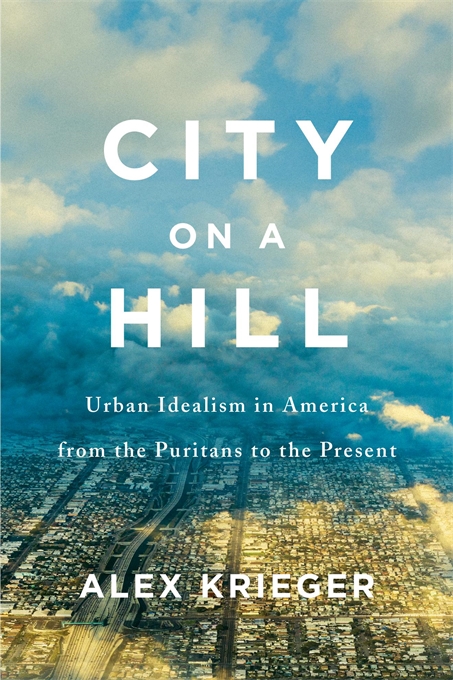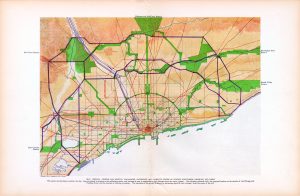Alex Krieger
Belknap Press, 2019

This work is a collection of 18 chapter-length essays, thematically organized from colonial times to the present, on American utopian communities. The author, Alex Krieger, is a practicing urban designer and distinguished academic, and one assumes this work presents personal reflections informed by his career in each realm. While there’s much to admire, his discussion is not without troubles that cause concern.
Krieger writes that “Generations of Americans … have shaped cities with a utopian resolve to build a better future. The traces their dreams have left on our cities are the subject of this book” (xi). His aim is not to locate utopia but to focus on utopian experiments in an effort to interpret patterns characterizing American urban life. Krieger hesitates to discuss the American culture as completely utopian. He states that he’s aware of the many histories that must be written dealing with issues like slavery—but that’s not his focus. Yet discussion of those issues, together with the author’s historical perspective, would have provided a more comprehensive context for understanding contemporary urban issues (climate change, political polarization, social justice, and economic inequality) and for informing design responses to issues that have lately emerged (COVID-19, Black Lives Matter, and open space equity). Nevertheless, his work should provide useful historical backdrop for those discussions, and, with its emphasis on utopian communities, it could augment syllabi in urban history, cultural landscapes, and urban design.
Chapters here are generally the same length; drawing on diverse references and weaving numerous threads together, they read as if they would make entertaining lectures. Several are particularly insightful. After discussing 19th-century American utopian communities, the author follows with observations on American attitudes, over time, about urban evolution. In Chapter 2, “A Nature’s Nation in the Garden of the World,” the author discusses artist Thomas Cole’s five-canvas series, The Course of Empire (1836), juxtaposed with the Chicago World’s Fair (1893). Other notable discussions are Chapter 4, “The Small Town as an Ideal: Puritan Covenants to Celebration, Florida,” which follows a broad evolutionary arc from colonial times to New Urbanist communities, and Chapter 5, “The Company Town Away from Town,” which discusses communities such as Kohler, Wisconsin, built for the plumbing equipment factory’s workers. Curiously, Krieger fails to mention Kohler’s designers, city planner Werner Hegemann and landscape architect Elbert Peets, who planned several such communities and later published The American Vitruvius (1922), the basis for much of the New Urbanism movement. In Chapter 8, “Making Nature Urbane: Olmsted and the Parks Movement,” Krieger argues (as do most scholars) that Frederick Law Olmsted, along with “others of that remarkable first generation of landscape architects” (152), was really an urban planner, advocating for urban parks and park systems. Krieger erroneously lists George Kessler (1862–1923) as being in that group; instead, Kessler, a contemporary of Olmsted’s stepson and son, was part of the equally remarkable second generation. Other chapters focus on individual national trends such as urban renewal and specific urban situations.

It is in Chapter 17 (“New Orleans and Attachment to Place”) that inaccuracies and omissions become troublesome. This chapter concerns Hurricane Katrina’s aftermath, which seems out of place in a discussion of utopian communities. Krieger links utopian communities and New Orleans with a quote from Albert Camus’ essay “The Myth of Sisyphus”: “The struggle itself toward the heights is enough to fill a man’s heart” (321). The author’s justification is that he wants to connect the characteristic optimism of such communities with the fatalistic attitude of those (myself included) who choose to live in a city that is below sea level, sinking, and susceptible to unpredictable hurricanes and regular flooding (due to inefficient and outdated drainage infrastructure). While Krieger conflates levees with floodwalls (illustration 17.1), post-Katrina flooding resulted from floodwall—not levee—failures. Bayou St. John does not connect Lake Pontchartrain with the Mississippi River (323). The Vieux Carré is not home to the city’s “old and wealthy society.” While it is true that the Black, lower-income Lower Ninth Ward suffered, importantly the author neglects many other neighborhoods, neither Black nor poor, a myth reinforced by a “Katrina-inspired [newspaper] cartoon” (329). Krieger accurately describes the city’s topography as a saucer but inaccurately describes the Lower Ninth Ward as the “bottom of the bowl” (328). Straining through a racial lens to connect the 1927 Great Flood with the Lower Ninth Ward, he states a decision was made to dynamite “a section of levees [sic] some thirty miles upstream” from New Orleans (330); the levee dynamited was downriver, and much of the displacement and racially-motivated mistreatment of Blacks happened in Mississippi’s Delta region, miles from New Orleans, which did not flood. The image given supporting this connection (331) is, in fact, of a community 150 miles northwest of the city. Finally, Krieger fails to discuss changes in public attitudes and policies about drainage, specifically the “Living with Water” initiative prompted by the post-Katrina “Dutch Dialogues.” Post-Katrina efforts by out-of-town planning professionals (including Krieger and his office) were largely missed opportunities, and much could have been learned from examining them.

The work is not well served by its presentation. Black and white images are sometimes muddy or too small, and their placement does not always coincide with the text. Oddly, many black and white images are also given in color in the book’s center, but their captions are not linked to the text. Historical maps and plans comprise but a small portion of images given and are largely useless. There is no bibliography. Finally, proofreading glitches happen more than they should: “Euro Saarinen” (104) and “self-proclaimed profit George Rapp” (257) are just two.
Perhaps such production problems won’t matter to those more interested in the subjects discussed than in their presentation; nevertheless, readers would be well advised not to accept what’s here without further investigation.
Lake Douglas, PhD, FASLA, is professor at LSU’s Robert Reich School of Landscape Architecture and associate dean, College of Art + Design. His most recent book, with co-author Karen Kingsley, is Buildings of New Orleans (2018).
How to Cite This: Douglas, Lake. Review of City on a Hill: Urban Idealism in America from the Puritans to the Present, by Alex Krieger, JAE Online, March 12, 2021.
All images used in this review are courtesy of Harvard University Press.






